This post may contain affiliate links. Please read our disclosure policy.
Make authentic French baguettes at home with this easy Baguette Recipe. Just 5 simple ingredients and foolproof techniques for bakery-quality crusty bread every time. The steam method provides the crispy, golden crust, while the stretch-and-fold technique results in an airy, chewy inside—just like from a real French bakery!

The perfect baguette is crispy on the outside, perfectly chewy on the inside, has a complex flavor, and is one of those breads that feel like such a simple pleasure in life. The ingredient list is short, but the flavor is amazing.
This Classic French Baguette Recipe looks a bit time consuming, but it really is basic, I promise. If you’re new to bread baking, you might want to check out more info on how to make homemade bread or try out this easy French bread recipe.
Table of Contents

🩷 Melissa
Even if you’re new to bread making, this recipe breaks down professional techniques into simple, manageable steps that anyone can do, I promise!
The stretch-and-fold method is easy to master and creates the gluten structure needed for perfect baguettes without traditional kneading.
The long fermentation process gives you incredible flexibility. You can adjust the timing to have fresh baguettes ready for lunch, dinner, or whenever you need them. The 12-18 hour cold fermentation window means you can easily fit bread-making into your routine.
Plus you only need five basic ingredients: flour, water, honey, yeast, and salt!

Classic French Baguette Recipe
Equipment
- medium mixing bowl I love these because they have lids and double as serving bowls.
- kitchen towel I love the off-white color of these kitchen towels. They wash up great and are even large enough to cover full sheet pans.
- baguette pan I own 3 of those and make tons of baguettes way too often!
Ingredients
- 1 1/2 cups + 2 tablespoons cool water, 370 grams
- 1 tablespoon honey, 25 grams
- 1 teaspoon instant yeast, 3 grams
- 3 1/2 cups all-purpose Bob’s Red Mill or King Arthur Flour brand flour, 500 grams
- 2 teaspoon fine sea salt, 10 grams
Instructions
- In a medium mixing bowl, add the water and honey to the bowl and stir to combine.
- Add the yeast, flour, and salt to the bowl and use a wooden spoon to mix well. The dough will be thick, just stir it as well as you can until the flour is incorporated. No need to mix a lot by hand at this point, just get it to come together.
- Cover the bowl using use a lid, beeswax wrap, or some good cling wrap, and let the dough rest for 30 minutes.
- After 30 or so minutes, stretch and fold the dough. Here's what I mean by "stretch-and-fold:" Put your hand between the dough and the bowl on one side and grab the dough, gently pull it up to give it a good stretch. (If the dough starts to break, stop pulling. Your are just stretching the dough as far as it wants to stretch without breaking it.) Then fold it back down into the middle of the bowl. Give the bowl a quarter turn and repeat the process, working your way around the bowl. I normally think of the bowl as a square and stretch and pull the dough 4 times, once on each side of my square. It'll take about 15 seconds to do this.
- Over the next 2-3 hours, every 30 to 45 minutes, do a stretch and fold with the dough. Be sure to cover the dough well after each session. Do around 4 stretch and fold sessions total, though doing more won't hurt anything.
- See the baker's schedule in the post for more information on how and when I do this. I normally make my dough while I'm making dinner and stretch and fold throughout the evening.
- After you have stretched and folded the dough, cover the dough well and place it in the fridge for the next 12-18 hours.
- You have some flexibility about how long the dough is in the fridge, so feel free to make the baking schedule work with your schedule. I adjust the next day's baking depending on when we want to eat the baguettes. If they are for lunch, I'll get the dough out of the fridge 3 hours before we want to eat lunch. If I want them for dinner, I'll get the dough out 3 hours before dinner. If you don't have a set time for you want to eat them, you can just do these next steps when you have about a three-hour chunk of time to dedicate to it—it's not all hands-on time but you'll need to be able to do the steps as needed.
- Remove the dough from the fridge after its 12 to 18 hour rest, and remove it from the bowl.
- Divide the dough into three even pieces.
- Gently press each piece of dough into a rectangular shape about 1-inch thick. If the dough is very sticky, feel free to lightly flour your surface. Cover the pressed out dough pieces with a clean dish towel and allow to rise for 1 hour.
- After the dough has rested for an hour at room temperature, it's time to shape your loaves. Working with one piece of dough, stretch the dough gently so that it makes a rectangle that is roughly 11 inches by 8 inches. Fold one-third of the dough to the middle of the rectangle, fold the other side of the rectangle into the middle of the dough (like you are folding a letter), and then pinch the dough together along the seem to make a log. (See the step-by-step photos in the blog post.)
- Use both of your hands to gently roll out the dough into a 15-inch long log, tapering the ends just a bit with your hands.
- Place the prepared dough log into your baguette pan.
- Repeat with the remaining dough.
- Cover the dough in the pan with a clean dish towel and let rise for 45 minutes to 1 hour or until the dough is light and puffy—it won't be quite doubled in size.
- While the dough is rising, preheat your oven to 500°F. When you turn the oven on to preheat, add a small dish of water to the oven. I like to use a bread pan that has about 2 inches of water in it. I put it off to one side of the oven so that my baguette pan can fit next to it. I like to let the oven and water preheat for at least 30 minutes so that it has time to get good and hot.
- When the bread has finished rising in the baguette pan, use a razor blade or lame to cut 3 diagonal slashes 1/2inch deep diagonally across each loaf OR cut one long 1/2-inch deep slash down the center of each loaf. (I like the center slit personally.)
- Place the bread in the hot oven, being careful when you open the oven as it is hot and steamy!
- Close the oven door and reduce the heat to 450°F immediately.
- Let the baguettes cook until they are deep golden brown, 24-28 minutes. (I like to do 25 minutes on the dot.) They are going to be very golden!
- Remove the baguettes from the oven and allow to cool 10-15 minutes before serving warm.
Video
Notes
- I like using a scale for this recipe and measuring that way, the more I use a scale for baking the more I love it. It’s a lot more consistent!
- You can totally use your stand mixer for this. Sometimes I’ll make my dough in the stand mixer and just let it hang out in there for the next few hours. I’ll cover the whole things lightly with a towel and then for my stretch and fold sessions, I’ll simple turn the mixer on for 15 seconds and let it do the kneading. It works great!
- If you don’t want to buy the baguette pans, I thought the King Arthur Flour baguette recipe did a good job of explaining how to use the cloth, peel, and a baking stone! I bet you could look up some videos on YouTube too.
- Uneaten baguettes can be stored wrapped in a clean towel and make excellent bread for sandwiches. Avoid storing them in plastic bags, as this can make the crust lose its crispness.
- To reheat, wrap the baguette in foil and warm in a 350°F oven for 15 minutes.
- For longer storage, freeze baguettes by wrapping them in foil and placing them in a freezer-safe bag. Freeze for up to 3 months. Thaw at room temperature and reheat before serving.
Nutrition
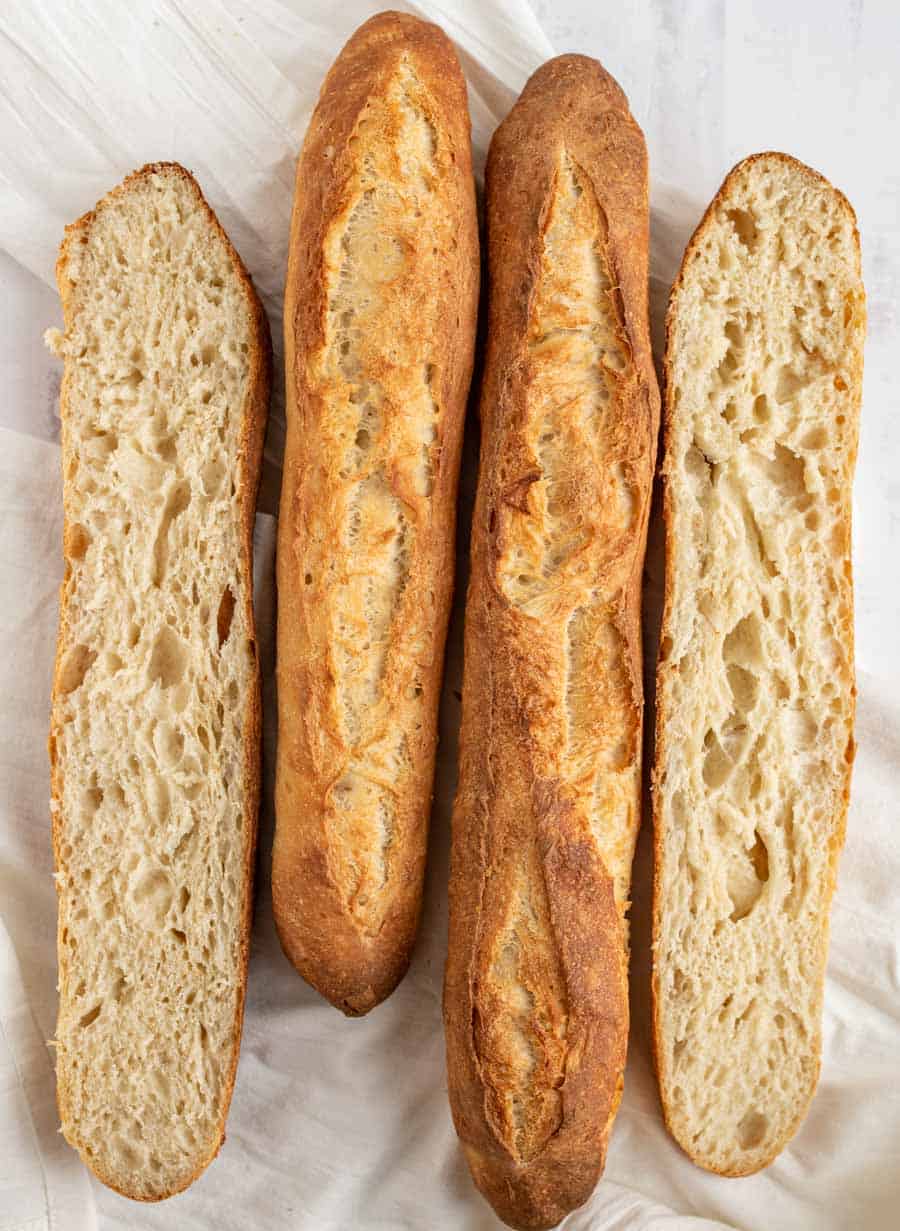
How To Stretch and Fold Your Dough
First, you’ll mix up your dough; it comes together really easily just by stirring it with a wooden spoon. Then, over the next 3 or so hours, you’ll “stretch and fold” your dough every 30 to 45 minutes or so for a total of 4 times.
Don’t overthink this part, the timing isn’t a huge deal, so don’t sweat it if you do it a little more or less and a little faster or slower than at the 30 to 45 minute mark. The idea is that you knead the dough just a bit, a few times, over the course of a couple of hours. It’s way flexible. This helps to make the inside of your baguette perfectly chewy.
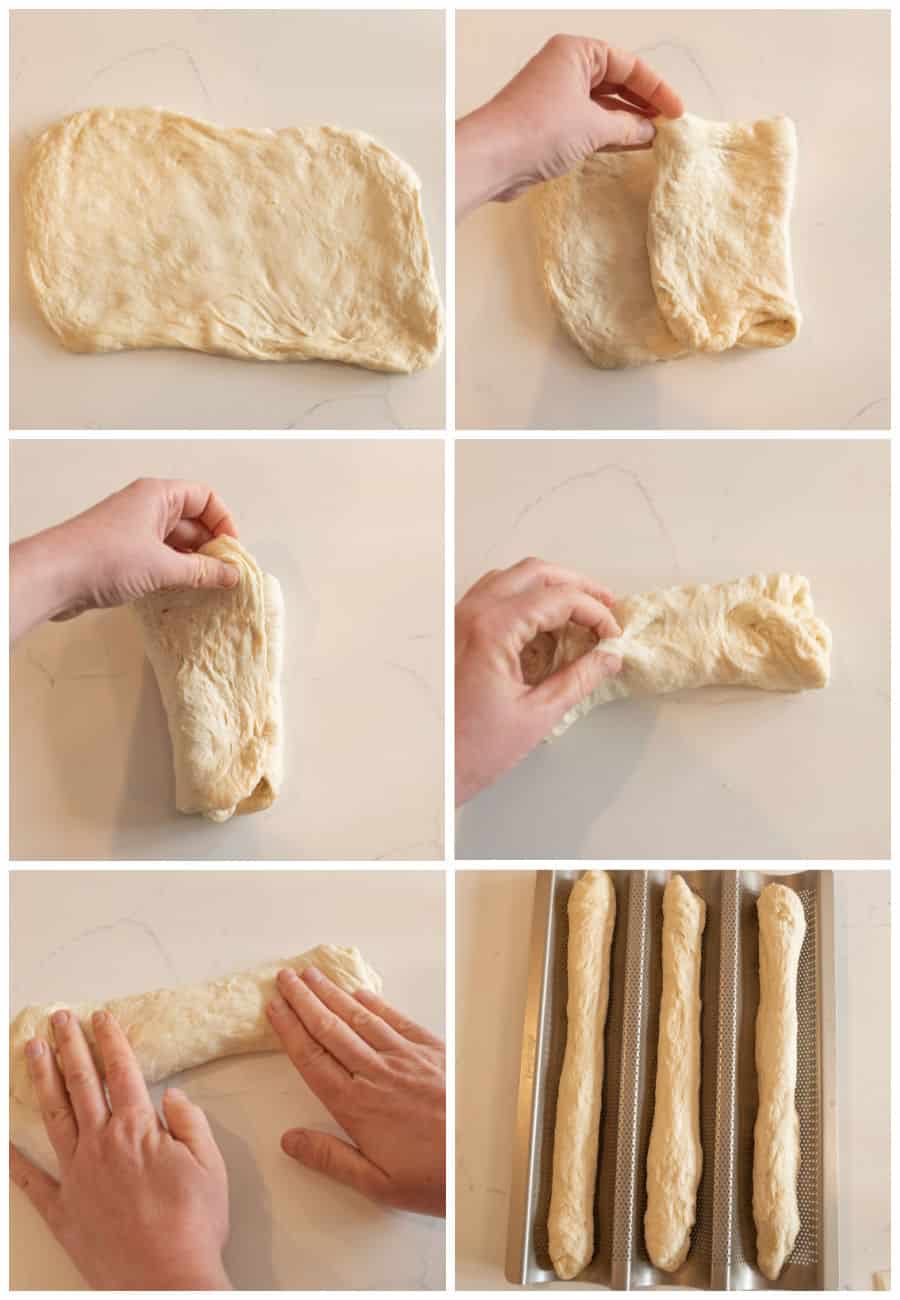
When I say “stretch and fold,” here’s what you do: Put your hand between the dough and the bowl on one side and grab the dough, gently pull it up to give it a good stretch (if the dough starts to break, stop pulling, you are just stretching the dough as far as it wants to stretch without breaking it) and then fold it back down into the middle of the bowl.
Give the bowl a quarter turn and repeat the process, working your way around the bowl. I normally think of the bowl as a square and stretch and pull the dough 4 times, once on each side of my square. It’ll take 15 or so seconds to do this.
Do this a few times over the next few hours. Then, cover up the bowl well with a beeswax wrap or a piece of plastic wrap and put it in the fridge for the next 12-18 hours.
After your dough has chilled for 12-18 hours, remove it from the bowl and divide it into three even pieces.
Pat the pieces of dough out into rectangles (don’t worry too much about the shape, the cold dough is pretty stiff, just pat it out) and are about 1 inch thick. Cover with a towel and let rise for 1 hour.
Recipe FAQs
Once the dough has rested at room temperature for an hour, pull it into a rectangle that is about 11 inches by 8 inches. Then, fold the dough into thirds, as shown in the pictures above. Once the dough has been folded, pinch the seem shut.
Gently use your hands to roll the dough log out into a baguette that is 15 inches long. Use your hands and the rolling motion to taper the ends gently. Then, place the baguettes in a baguette pan. Repeat with the remaining dough. Let the dough rise for about an hour in the baguette pan, and then bake!
Baguettes are best enjoyed fresh on the day they are baked. To store them, wrap them tightly in a kitchen towel or paper bag to prevent them from getting too soft. Avoid storing them in plastic bags, as this can make the crust lose its crispness.
The outside texture is achieved by cooking the dough at a very high temperature AND by adding a pan of water to the oven so that it creates steam. The steamy cooking environment mixed with the high temperature are the things that make perfect baguettes.
By using a slow fermentation process for this dough, you develop the flavor of the dough. After the dough has been made and you’ve kneaded it a few times over a few hours, you’ll cover it well and pop it in the fridge for 12 to 18 hours (depending on your time schedule). This method of cold retarding the dough is where so much of the magic is made. This slow rise is also changing the texture of the dough! So it’s a double win.
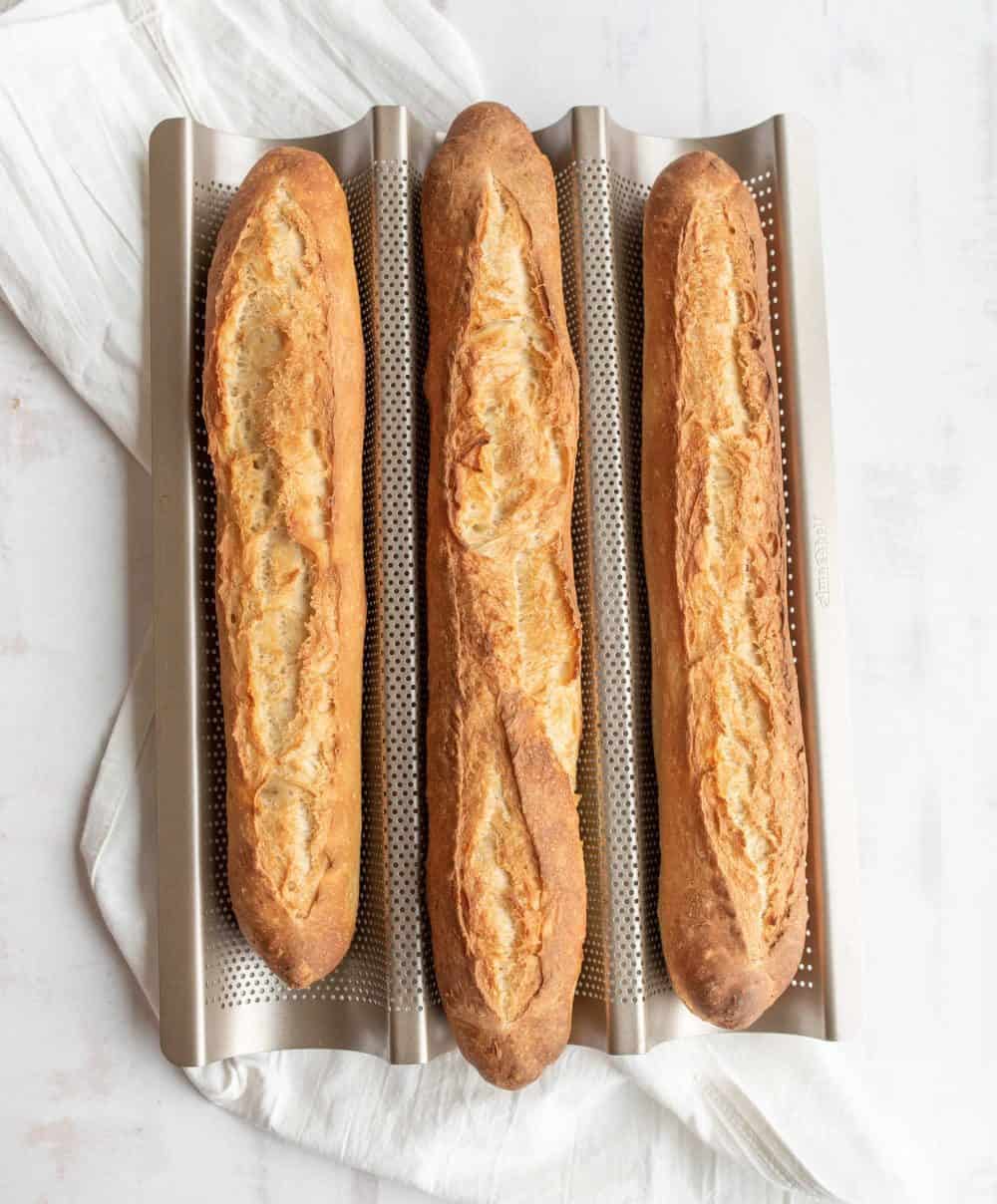
Special Equipment Needed
After much trial and error, I did decide that buying a baguette pan was worth it. The bread rises right in the pan, and the pan goes right in the oven. It doesn’t take up a lot of room to store and I’ve liked the results. The pans aren’t expensive either.
You’ll need a razor blade or a bread-slashing tool called a lame. You can use a very sharp serrated knife to cut the slits in your bread before baking, but I’ve found a razor blade or lame just to work so much better. It will cut deeply without tearing the bread or roughing it up too much (you can deflate the risen dough by using a knife that doesn’t cut well for scoring).
Expert Tips
- Weight, Not Measure: I like using a scale to measure ingredients for this recipe, the more I use a scale for baking the more I love it. It’s a lot more consistent!
- Make Extra: You can double this recipe, it works great. I always make a double batch for my family. I like to bake the pans separately though (they bake up better one pan at a time in my oven).
- Baguette Pans: You can find lots of baguette pans online. I like the ones that are carbon steel and this is the one that I bought.
- Scoring Tool: You’ll want to use a razor blade or lame for slashing your bread before baking. A lame is just a razor blade on a stick but you might like the feel of it better. This tool is also used for scoring sourdough bread.
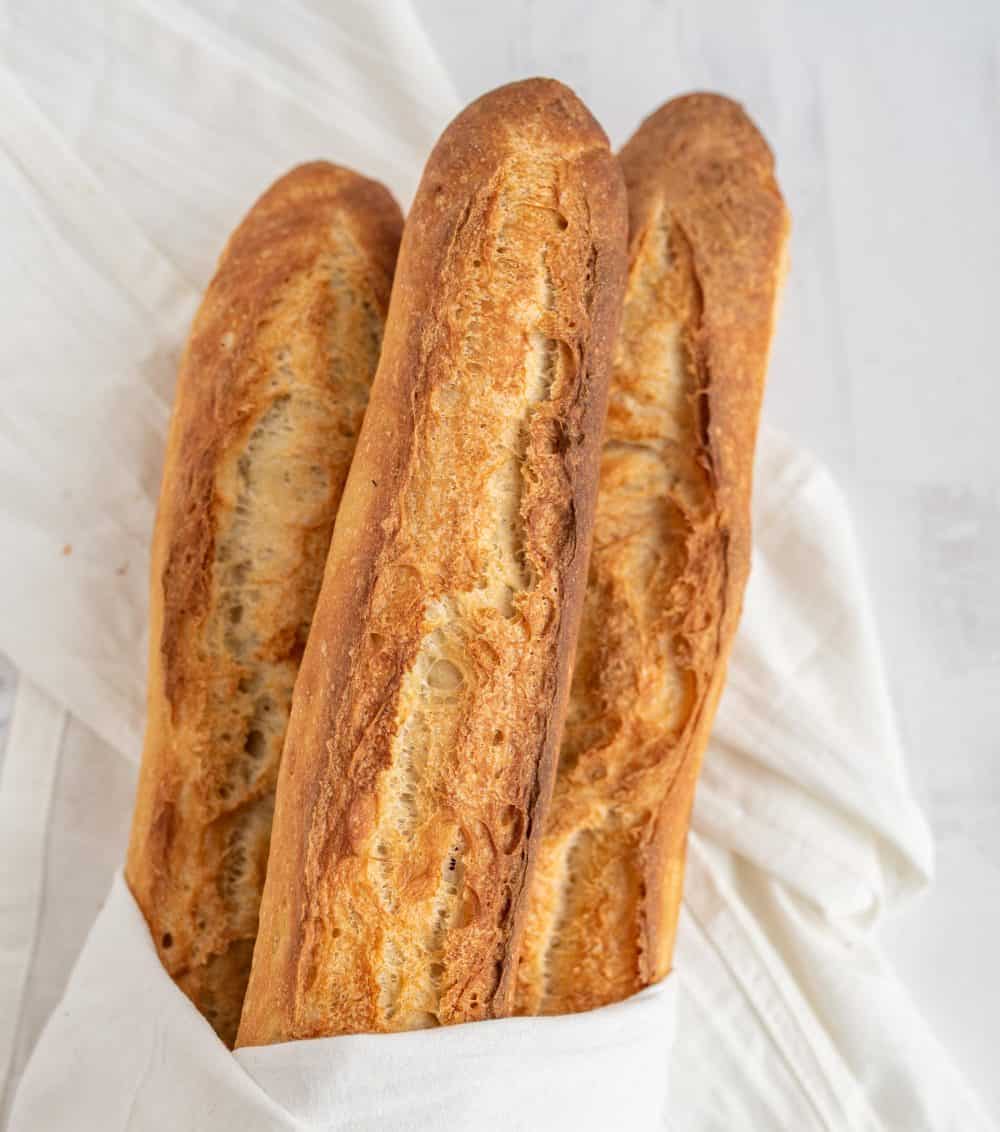
More Yeasted Bread Recipes to Consider
Yeast Bread Recipes
Instant Yeast vs Active Dry Yeast — Quick Baker’s Lesson
Yeast Bread Recipes
Garlic & Parmesan Italian Breadsticks {Twisted Breadsticks}
Snacks
Big Soft Pretzels
Homemade Bread
100% Whole Wheat Bread Recipe
Did you make this recipe? Leave a ⭐️ review and share it on Instagram, Facebook, or Pinterest!




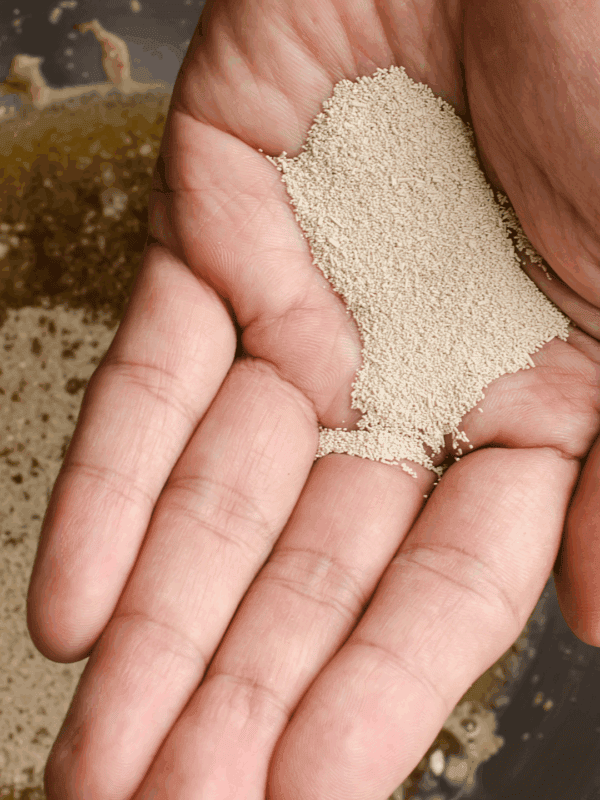
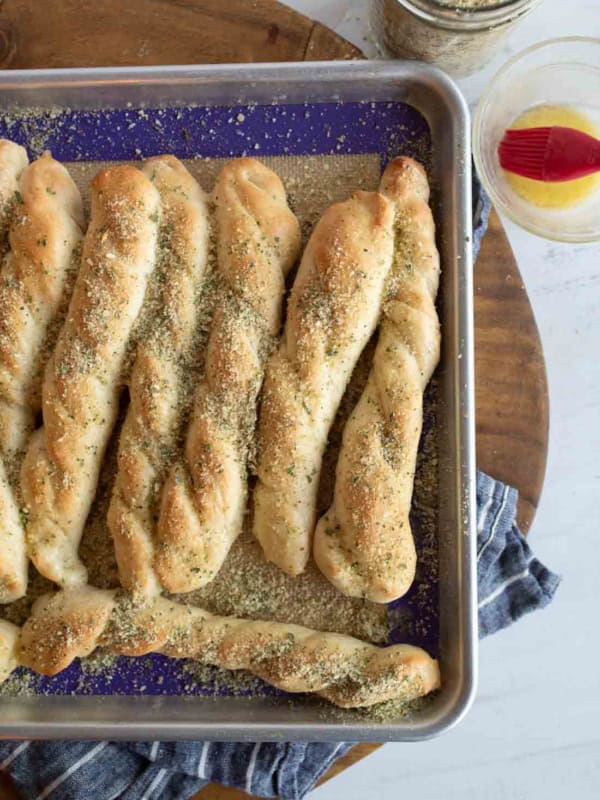

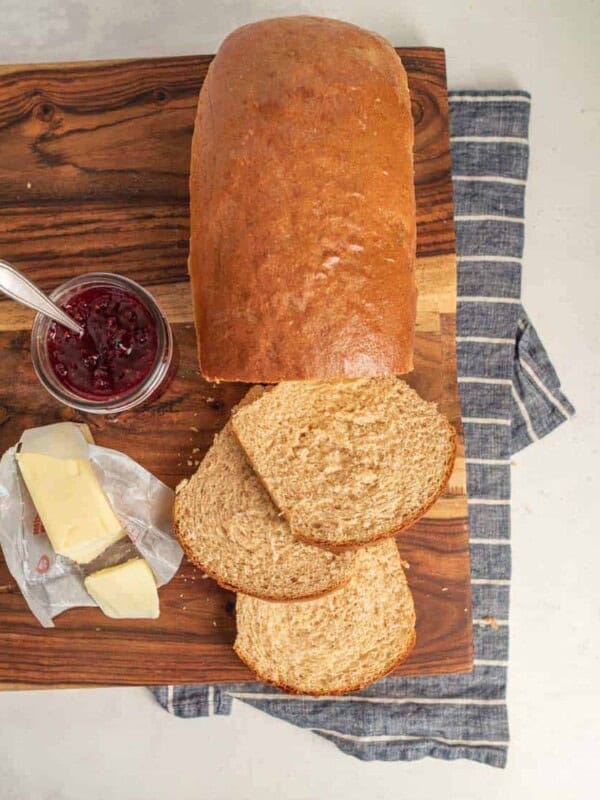






Hello, Melissa. I tried the recipe and turned out awesome! My family loved it. I followed the receipt and used 1 tablespoon of honey, 25 grams.
I am wondering if the honey can be replaced with malt powder? If yes, how much can it be added to the recipe?
Thank you.
I haven’t used malt powder before! I’m not really sure but I get you can play with it, it’s a pretty forgiving recipe.
Excellent recipe. I have done this once & I am going to tackle it again.
Very good baguettes.
It only gets easier with practice Shauna! I’m so excited you made these!
I make this bread often. My friends say it’s better than any bakery French bread.
Scarlett, I LOVE that you are making these baguettes, we are obsessed too. Thanks for the review!
Really solid recipe. I’m curious if it makes a difference where the rack is positioned in the oven. I’m kind of wondering if I’m alone in believing the bread should bake on the bottom shelf verse the top shelf.
I’ve only made the recipe once, so I can’t say that I’ve tried it to find out. I’m wondering if anybody has any insight before do the experiment on my own.
I use the middle but feel free to experiment with your own oven!
Excellent recipe for beginners. This was my first attempt at shaping baguettes and it was an easy process to follow. My baguette pan only holds two loaves so I shaped the remaining third into a small boule and baked that in a parchment lined ceramic dish. I imagine the boule would do even better baked in a small Dutch oven. I use a convection oven (no choice, all my apartment has) and adjust the oven temperature to accomodate, but I think I cooked these too long or at too high a temp because they were really dark, so will experiment with that next time. Even over baked, the bread tasted good :).